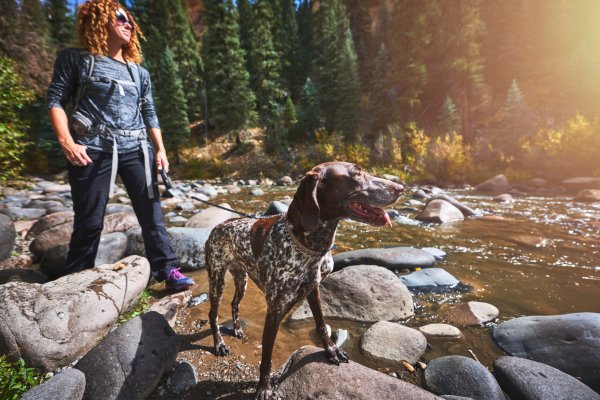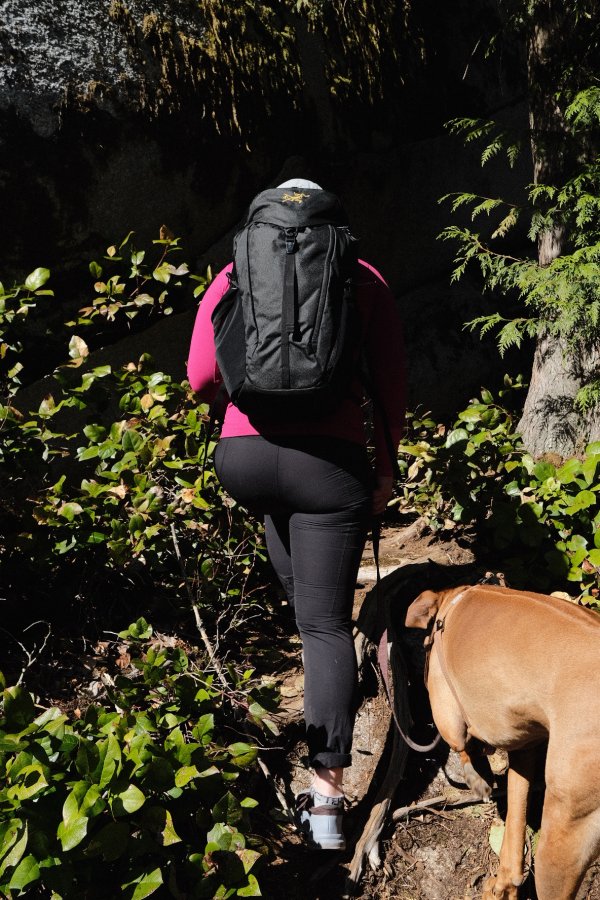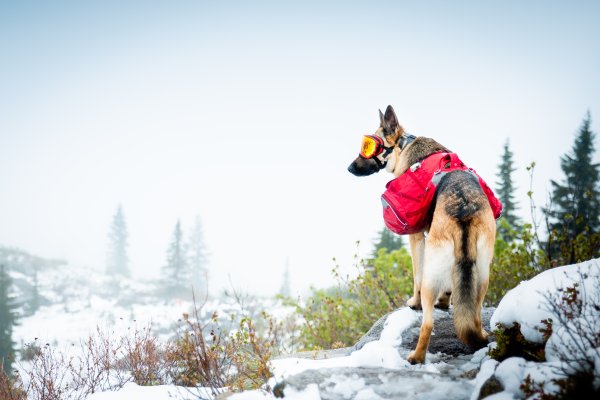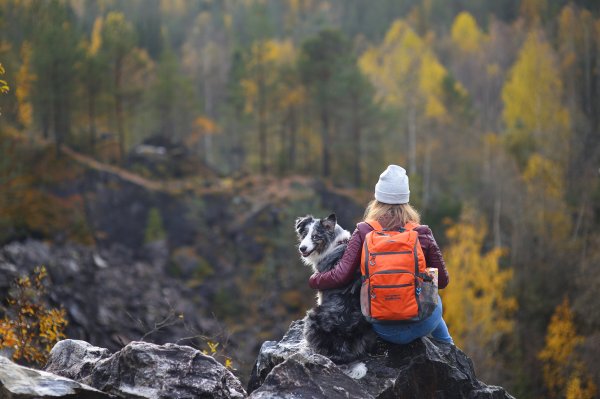Guest Post: Abby Cooper

The core of the connection between human and dog is unspoken. Sure, there are a handful of words or commands that land, but the essence is deeper than words. It’s the tail wags while loading up the car for an adventure knowing they get to join. It’s the big smile after a swim together in an alpine lake right before you’re a victim of the spray from a big cold shake. It’s the content side by side with a view. It’s undeniable - sharing adventures with your pup is pretty dang special. It’s a time where trust and memories can flourish. But let’s be honest: this is how it looks for the seasoned and well-trained pup - expecting all of these magical moments without putting in the work is, without pun, far-fetched.
Equal parts training for Fido and education for you are essential for sustainable and frustration-free adventures. It’s also instrumental for those around you, those who will visit after you, and for the landscape's longevity. Here’s how you and your pup can be responsible backcountry adventurers.
The choices you make on your dog’s behalf will have a lasting impact on their health, quality of life and longevity. Responsible dog ownership starts with safety, effective mitigation strategies and preparedness.

Trail Etiquette
Give space and practice empathy here. The hard truth is that no one loves your dog like you love your dog. Any dog, from a chihuahua to a doodle to a rottweiler, can be seen as scary, uncomfortable, dirty, smelly, or overbearing to a stranger. Assume that people don’t want to pet or be surprised by your dog unless they say otherwise.
Leave No Trace, it’s not just for humans. Picking up poop to pop into a nearby trashcan is just part of having a dog. When those trash cans get further apart, this somehow becomes a harder task. I get it, packing out poop isn’t fun, but there’s a solution that’ll change the game. Do your regular poop bag routine and put it into a dry bag like Pup Pouch or similar. This dry bag keeps the stink inside and eliminates the risk of any bag breaks and messes. Simply empty it when you’re back in civilization, turn it inside out, soap it up, hose it down and let it air out in the sun. No traces of Fido, no stench from Fido’s droppings is a win-win. Poop carried in biodegradable bags can be emptied into pit outhouses.
On the topic of leaving no trace, this is a gentle reminder to do the same for yourself. If you’re not familiar with pooping in the wild brush up on this blog - your poop is also a threat to our beloved fuzzy ones. Please take proper care. Always follow the 7 Principles of Leave No Trace.
Not picking up yours and your dog’s poop can create many unintended and harmful consequences on the ecosystem. Dogs, like us, are visitors to the outdoors, and are not active parts of the ecosystem; meaning the nutrients they get from their food (whether it be kibble or raw diets) are not from the environment and can disrupt the natural balance of elements. Dog poop contains high levels of nitrogen and phosphorus, and if it enters bodies of water can contribute to algae blooms that can damage and even devastate aquatic ecosystems.
Leash or not to leash? The answer is either obvious from the parking lot with a glaring “pets must be on a leash” sign, or the answer is murky. The only way to cut through the murk is to do your research before you’re out of service and in the thick of it. As mentioned, if leashes are mandatory, signage will usually spell it out, but there are other considerations as to when and if a lease should be utilized even if not mandatory such as wildlife, sensitive vegetation, exposure or risk to your or your pup and so on. Let’s dissect the best we can.
Ensure dogs are welcome before you set out on your trip. Some National, Provincial, State and Regional parks do not allow dogs, or only if on a leash.

Consider the BARK system for dog safety in parks:
B - bag your pet’s waste
A - always leash your pet
R - respect wildlife
K - know where you can go
National and provincial parks will often state if dogs are allowed which is step one. If they are allowed, read up on whether leashes are required through the entirety of the park or just on specific trails. If you are not in a park, rec sites often provide criteria or recommendations. If information is scarce, this is when you get to trust your judgment bearing in mind that proper trail etiquette is always mandatory. If you choose to let your dog off leash will they listen to you and not chase a squirrel? Is their recall good enough to have them right by your side when required to have them out of the way of others or avoid danger? This standard is expected. If you’re biking I would say the unwritten rule is that it’s unsafe to bike with a dog on a leash for both of you - but - it is still expected that they will listen, stay close and have basic commands like “get back”, “on the trail”, “off the trail” and/or “leave it” locked down.
Planning For Your Dog
Know before you go. If you are exploring the outdoors with your dog, be aware of the environment and its inherent risks and hazards. The more remote the activity, the more prepared you should be for extreme conditions. The scope of even more minor illnesses or injuries can become more serious when they occur under challenging conditions.
We won’t claim to be the experts on this exact matter. It’s more personally related to your dog's fitness, experience, and training, as well as yours. But some considerations are key when choosing a suitable adventure. Use the items below to think critically about your plan with your pup in mind before setting out.
Plan
All adventures begin at home when you are planning the trip. No one expects that they (or their pup) will get into trouble out there. Filing a trip plan using the BC AdventureSmart Trip Plan App is a great way to leave your details with a trusted friend or family member. You can add details about where you’re going, what you’re wearing and who you’re with. Fill out your fur companion’s info in the ‘miscellaneous information’ tab. They rely heavily on you, so don’t make them wing it. Set them up for success.
Pack along BARK First Aid’s Dog Safety Field Guide, which is filled with life-saving information about first aid, CPR and many dog safety tips in the outdoors.
Weather
Heat plays a key role in this in the summer, the golden rule for heat exposure for dogs is Larger dogs might drink 0.5 to 1.0 ounces of water per pound per day. Dogs 20 pounds and lighter will be closer to 1.5 ounces per pound, per day. These are general guidelines and heat and vigorous activity often lead to requiring more than this. Check your pup's nose and gums to indicate if they are underhydrated—a dry nose and dry/tacky gums means more water, please! Cooling jackets or vests can be a good option to help with the heat as well. Opposite weather also needs foresight. The rain can make it hard to warm up for short-haired pups or dry off for long-haired pups. Consider, not only the amount of rain or snow, but also how you will keep them dry or warm them up.
Heat
Dogs cannot sweat like humans. Your dog’s primary method to cool down is evaporative cooling from the tongue while panting. Dogs can struggle to regulate their body temperature in extreme heat. Minimize your dog’s risk of heat stroke by providing adequate shade and protection, ventilation, and free access to water. Limit exercise during the hottest hours of the day.
Heat Stroke
Heat stroke can be life-threatening to your dog as it affects nearly all bodily systems including brain function. Heat stroke most commonly occurs when a dog has been confined in a hot vehicle, however, heat stroke can happen anytime, anywhere when your dog is exposed to warmer temperature. Signs include excessive panting, increased heart rate and temperature, difficulty breathing, weak and rapid pulse and eventual collapse. The dog’s temperature must be lowered as quickly as possible! Place your dog in a cool, shaded area or in a vehicle with air conditioning. Spray with cool water and fan vigorously to promote evaporation. Do not submerge your dog in water or ice as it may shock their system.
Cold Frostbite and hypothermia can happen suddenly if your dog has wet fur in cold, windy environments. Preventing hypothermia includes staying dry, warm, hydrated, sufficiently fed and avoiding fatigue.
Hypothermia
Lowering of dog’s body temperature below 36.5 Celsius. Signs include shivering, progressively worsening weakness, and collapse. Move your dog to somewhere warm and sheltered. If wet, dry as best as possible. Warm using blankets, towels, or your own body heat.
Frostbite
This occurs when the fluid in body tissues freezes. Frostbite happens more commonly on areas that are sparsely covered in fur, such as paws, scrotum, ears and tip of tail. The skin may appear waxy, white, grey or purple-tinged. Fluid-filled blisters may form as well. Rewarm the affected area gradually, as the sensation can be very painful when frozen tissues thaw. Do not rub the affected area and do not pop blisters. Immerse the affected area in lukewarm water until tissue becomes flushed.
Access to Water
Hydration. Do you need to filter it? Pack it in? Or is drinking o’natural is okay? Refrain from letting your dog swim in or drink from water that is noticeably discoloured, has surface “scum” or appears greasy. Microscopic organisms such as blue-green algae can become a hazard during hot seasons in shallow, stagnant bodies of water. Exposure to water-borne pathogens can be toxic, and potentially fatal to dogs if consumed.
Monitor water uptake and eating habits and provide clean, fresh drinking water at all times. Dehydration can result in fatigue, and lead to joint and musculoskeletal injuries. Frequently offer clean water to reduce the risk of dehydration. Dogs can drink up to 4L of water per day.
Elevation and Distance
5km flat is much more reasonable than with a 25% grade. Think about what your dog's baseline is and slowly build on their fitness. Don’t jump in with a big hike too soon or you’ll both be paying for it.
Terrain
Rocky, rough, mucky, or smooth sailing? Understanding the physical demand on your dog and their paws is important and will affect what you pack for them. Although much tougher than the pads on our feet, your dog’s paws can sustain cuts, scrapes, abrasions and even burns from walking on rough, uneven or hot terrain (hot asphalt can cause significant burns in under 30 seconds). Managing paw injuries can be deceptively challenging, as they are often prone to delayed healing, infection and are painful for dogs. The best method to deal with paw injuries is to PREVENT them from happening in the first place - by easing into longer walks in rough terrain, wearing booties and avoiding walking on shale or rough rock beds.
Are they prepared?
Vaccinated, ID tag on, fitness ready, recall on point, flea and tick medication up to date? Have your dog examined by a veterinarian regularly to keep vaccinations and parasite treatment up to date. Consistent health and wellness checks can help detect early disease onset, and ensure you make informed choices that benefit your dog’s health.

K9 Essentials
Just like the BC AdventureSmart essentials for every adventure, there is a similar list for our pups that are to be packed in addition to our own personal essential items.
1. Food + bowl: We often bring high-calorie snacks on adventures that are packable and light. This exists for dogs too! Come prepared with extra food and treats in a sealed container or animal-proof bag as well as a bowl to ensure we don’t leave anything behind.
2. Water: How are you sourcing it and does it require any care before drinking?
3. Dog attire: Collar with ID tags, leash and, for some people, this includes a harness or e-collar, depending on personal preferences and dog training. Attire also includes booties if needed for the cold or rough terrain
4. Warmth: Bring a dog jacket, blanket, or bivy pending how long you’re headed out! Dog jackets are worth their weight in gold for cold, windy or overnight adventures. In a pinch, a large garbage bag can be fashioned into a makeshift jacket.
5. First aid: Build your own (don’t forget the vet wrap) or check out BARK for great pre-packaged K9 first aid kits.
6. Bags: Poop bags + carrying bag (dry bag)
7. Medication: If your pup relies on medication, don’t forget to pack it.
8. Overnight essentials: This depends on the temperatures and your dog's coat, but it’s a good idea to bring a dog sleeping bag (like the Rufwear Highlands Dog Bed) and a small mat (like a Therm-a-Rest Z-Lite that can’t be punctured by their nails) to get them off the ground as well as a light or reflector for keeping track of them in the dark hours. A well-fitting pack that won’t chafe is important. Check out this Rufwear blog on finding the right pack for your dog + adventure.
9. Bear Safety: Remember that dogs can attract bears. We should always have bear spray on us and practice bear safety to the utmost degree when travelling with dogs so that we don’t attract wildlife. Check out WildsafeBC for tips. Although most bears (among other apex predators like cougars and wolves) avoid conflict, if cornered they may act to protect food resources or their young. To prevent surprise run-ins, stay alert in bear country! Keep your dog leashed and carry bear spray.

Safety
There are some extra measures you should take for safety while exploring with your dog. You don’t want to be “that person” who had to call SAR for a non-emergency emergency that was just a result of poor planning. So let’s tackle this right now.
Knowing when to act, what action to take and when to seek a veterinarian’s assistance are some of the most important decisions you may make when your pet sustains an injury. There are many responsibilities associated with having a dog in the backcountry that should be considered and respected.
Handling injured, stressed or sick animals increases your risk of injury, and all precautions must be taken. Human safety is the priority at all times. Do not respond to an injured animal unless you are able to do so in a safe, calm and efficient manner. Take a pet first aid certification course so you are well-versed in safety and first aid. Report any injury, sudden illness or emergencies to your veterinarian; and if any first aid was given.
Muzzle
A muzzle is an essential safety tool to mitigate the risk of being bit when handling an injured or fearful dog. A muzzle should be applied to prevent an injured or fearful animal from biting you. A muzzle should be properly sized to the dog and have been worn to desensitize before times of emergencies. A triangular bandage can be used as a makeshift muzzle. Consult BARK First Aid Dog Safety Manual for a step-by-step guide. Dogs are pretty dang hardy and designed for the outdoors, but here’s what we need to keep in mind as it is easy to keep them healthy and happy throughout the hike as well as a few “just in case” items.
Paws
Paws get more seasoned with the season. Summer paws aren’t the same as winter paws and vice versa. Winter paws for long-haired dogs might need wax to keep the snow from balling up, weighing them down, and causing discomfort. Booties can also help with cold toes. Mindful for breakable snow or ice crusts. These can result in cuts and lower leg/paw cuts are hard to get to stop bleeding while on the go. Rock salt and other de-icing chemicals can be a source of major irritation on paw pads and in between toes - and is very toxic if ingested! Wearing booties and wiping paws down every time you come back indoors helps prevent the accumulation of irritants.
For summer paws, think about the heat here. Pavement isn’t the only hot surface. Exposure to a lot of jagged rocks or gravel can cut or dry out your pup's paws. This is especially true if you are mountain biking with your dog, as their movements are often fast and exert a lot of force on wrists and paws when running downhill. Endurance can build over the season but watch your surfaces here.
Medications + Allergies
Biting or stinging insects such as wasps, black flies and mosquitoes are found in abundance throughout the wilderness. Dogs are usually stung around their mouth, nose and paws. Many insect stings are harmless, but allergic reactions are possible. If unsure, research and speak to your veterinarian about the appropriate Benadryl dosage for your dog’s weight in case they have a reaction. DO NOT give your dog children’s Benadryl, as it is coated with Xylitol, which is an artificial sweetener that is toxic to dogs. Some dogs may require an EpiPen or similar. Please consult your vet for any medications. Please note the side effects of existing medications as sometimes heat can have adverse effects.
Training
Basic dog first aid is so important for making you both confident and prepared for all the unexpected elements. Bark First Aid has dog safety webinars, pet emergency/disaster preparedness courses, pet first aid certification courses and in-person training sessions - a great local BC resource. With experience in veterinary clinics as well as over a decade working in bush camps alongside dogs, Celine (owner) has dedicated her work to improving the standard of care for dogs in outdoor environments.
Transport
In a worst-case scenario, how will you be able to get your dog out if they are injured and unable to walk? This is something you’ll undoubtedly cover in a dog first aid course. Start with watching this BC AdventureSmart Emergency Evacuations with Pets webinar and continue with ordering a BackTrack Evacuation Kit. A makeshift stretcher can be fashioned using two jackets, two hiking poles and a few broad strips of fabric. Consult BARK’s Dog Safety Field Guide for instructions.
Check-in
Don’t forget to listen to your dog when it comes to new interactions - they’ll let you know with their body lingerie if they’re tired, stressed or having the best time ever. Although a happy dog may be willing to go all day, it is important as owners to ensure you can provide rest and a safe area for a dog to decompress between adventures. Although exciting environments are filled with fun and friends, excitement is perceived as stress in the body - and an overly excited or exercised dog can be under an immense amount of stress without outwardly showing it. Better to keep adventures shorter and within the dog’s ability threshold than too big and wishing you hadn’t put them in (and yourself) that situation.
Emergencies
If you do encounter an emergency, don’t panic. Stop, Think, Observe, and Plan (S.T.O.P). Making hasty decisions while you are in fight or flight mode can make the issue worse. Also, Search & Rescue incidents with dogs are unique. They can become anxious when SAR arrives, running away or behaving aggressively. Keep this in mind and plan what you would do in this situation. Some SAR groups carry muzzles for dog rescues and will provide the muzzle to the owner of the dog to place on their dogs (if at the scene) before SAR approaches the subjects, for their safety and the dog’s.
Include your dog in emergency preparedness and disaster planning to prevent problems occuring if you do encounter one.

Keep Up The Good Work
Don’t forget to give yourself a “good human” pat at the end of a big adventure when everything goes according to plan or note when you’re prepared for the hiccups that present themselves.
It’s important to recognize the impact we and our pets can have on nature, wildlife, and others. This is undoubtedly an added layer of complexity, but one that comes with a big reward. Because training and learning never stops, don’t forget to brush up on your skills so you and your furry friend can continue to explore for years to come!
Be part of the solution, not the impact.
If you want to keep learning, check out this BC AdventureSmart Webinar: "Emergency Evacuation With Pets" with Celine Rytz at B.A.R.K.
Essential Resources
General
- BC AdventureSmart
- BC Parks - Homepage
- CWSAA - Alpine Responsibility Code
- BC Parks - Responsible Recreation
- Hello BC - How to Travel Safely & Responsibly
- Indigenous Tourism BC - How to Travel Responsibly
- Leave No Trace
- Outdoor Recreation Council of BC - Recreate Responsibly
- Recycle BC - Pack Lean Leave Clean
- RecycleBC - Pack Lean Leave Clean - Toolkit
- Wilderness Tourism BC - ExploreWildBC Pledge
- BC Parks - KBYG Toilet Edition
- BCSARA - Outdoor Education
- Invasive Species Council of BC - Play Your Part
- Tourism Squamish - Responsible Recreation
- Tourism Whistler - Responsible Travel
- Vancouver North Shore - Know Before You Go
- Fire & Ice Aspiring Geopark
- Átl'ka7tsem/Howe Sound Biosphere
- Adventure Hub - BC Search & Rescue Association
- AdventureSmart Trip Planning App
- BC Wildfire Service App
Camping
- Camper's Code
- WildSafeBC - Bare Campsite Program
- Outdoor Recreation Council of BC - Recreate Responsibly
- BC Parks - Stay Safe in Bear Country
- BC Parks - Campfire Bans & Safety
- BC Parks - Backcountry Visitor Guide
- BC Gov - Know the Rules for Rec Sites & Trails
- BCSARA - Outdoor Education
- Invasive Species Council of BC - Campers
- AdventureSmart Trip Planning App
Hiking
- BC AdventureSmart
- CWSAA - Alpine Responsibility Code
- Outdoor Recreation Council of BC - Recreate Responsibly
- BC Parks - Backcountry Visitor Guide
- BC Gov - Know the Rules for Rec Sites & Trails
- BCSARA - Outdoor Education
- Invasive Species Council of BC - Play Clean for Hikers
- AdventureSmart Trip Planning App
Pets
Related Impacts

1 Garbage And Human Waste
The improper disposal of human waste and garbage is harmful to humans, the environment, and wildlife.
- Face masks collected by Vancouver plogger David Papineau
- 40,000
- Kilograms of trash removed by Divers for Cleaner Lakes and Oceans since 2013
- 29,188

3 Unsafe Behaviour, Lack Of Preparedness
Unprepared outdoor adventurists put themselves and others at risk of becoming a Search & Rescue or death statistic.
- Search and Rescue incidents per year in BC
- 1,750
- Volunteer hours spent annually on SAR call-outs, training, administration and SAR prevention in 2022
- 441,019

4 Lack of Respect - People & Environment
From trampling on trails to human-caused wildfires, disrespectful behaviour is creating conflict between user groups and damage to the environment and communities.
- Percentage of human-caused wildfires in BC, down from 42% in 2023.
- 30%